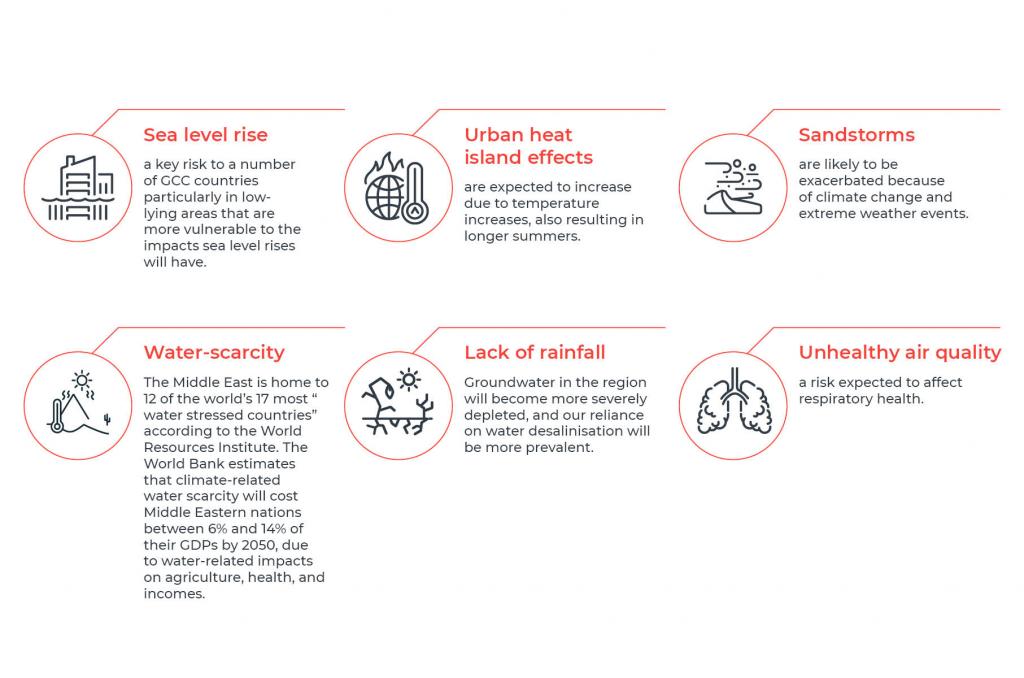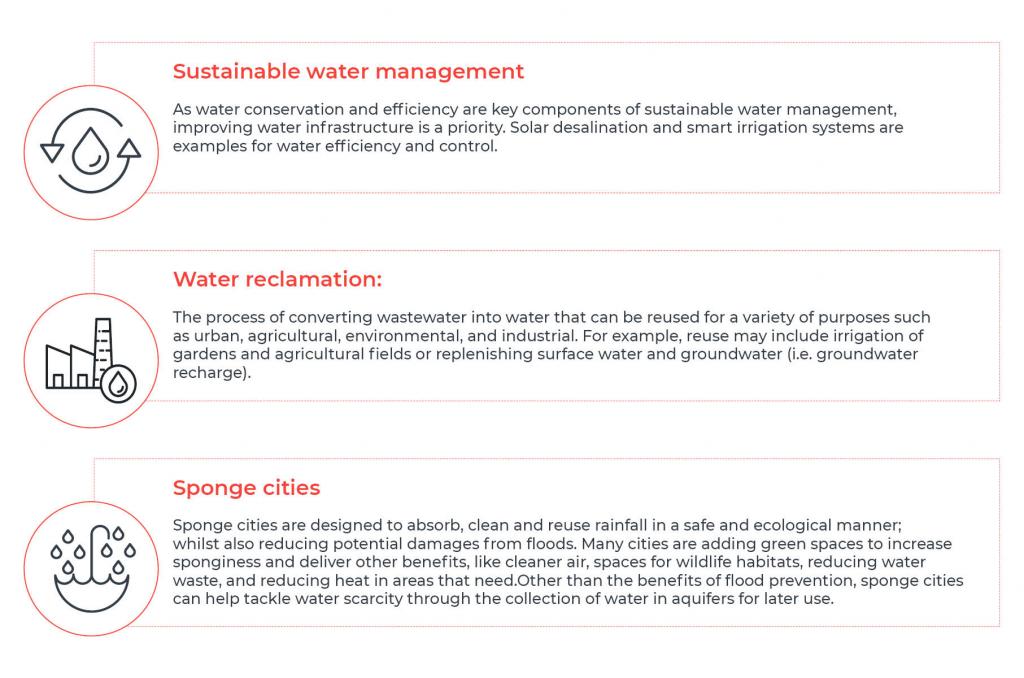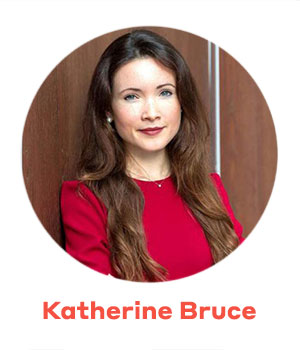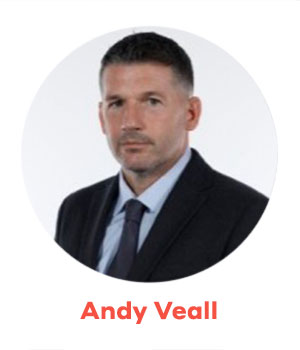Future-proofing Challenges Through Climate Resilience
Our region, today
Over the past period, human activity has been the key igniter of climate change. Burning fossil fuels, releasing chemicals into the atmosphere, reducing the amount of forest lands, and the rapid expansion of development and industrial activities are releasing greenhouse gases, particularly carbon dioxide into the atmosphere and altering the balance of our climate, hence contributing to global warming.
Regardless of how successful we have been at limiting the causes of global warming, our planet has been facing significant impacts from the harmful effects of climate change. The ability to anticipate, prepare, recover, and adapt to these impacts is what we call “climate change resilience.”
Our experts at WSP Middle East highlight the key climate change challenges The Middle East region is expected to face:

Improving climate resilience involves assessing how to counter these climate-related risks and taking actions to better cope with these risks. The scale of these climate challenges facing our region can seem frightening, but the question we must answer is: What can we do about it?
“The good news is: if we future-proof how we deal with climate changes and start addressing these risks, we do not only protect people and our planet, but we also contribute to generating better economic activity.” – May Faraj, Head of Environment & Sustainability.
“Decarbonization is not the only option; we need to ensure our infrastructure and buildings are designed to mitigate against the impacts that climate change is projected to have. This recognition has brought the discussion around climate change adaptation and resilience into the agenda of our clients.” – Katherine Bruce, Sustainability & Climate Change service lead.
Future-proofing
It’s become critical to pair recognition of changing environmental conditions with adequate risk management. In light of this, an increased commitment from developers towards climate-proofing against evolving climate hazards at the front-end of a project can help reduce risks and lower future costs.
“In our projects, we incorporate extensive Future Ready trend research, to ensure developments are resilient to future trends within climate change, resources, society, and technology. Our Future Ready approach has become embedded as part of our values, staff trainings, prospects, and as an overall baseline of WSP’s way of working.” – Sophia Kee, Head of Future Ready.
A key Future Ready measure we incorporate at a project’s early stages is utilising future weather data projections instead of only relying on historical data, for instance, focusing on future flood-risk zone maps, temperatures, and other climate parameters.
Research suggests that global sea levels will rise
between 20 – 30 cm by mid-century.
Sea level rise
Research suggests that global sea levels will rise between 20 – 30 cm by mid-century, wiping out at least a dozen cities worldwide; and the Middle East region is not exempt from the impact of rising sea levels
Therefore, a major factor to incorporate into design is water level increases, which could put developments at greater risk from larger waves or surge waves if an extreme magnitude climatic event were to unfold. Given that an increasing number of people and assets could be at risk at the coast due to the low-lying nature of these areas, it’s crucial to ensure that the formation levels of urban developments on these areas are raised to cater for increases in extreme water levels. This could mitigate additional stresses due to land-use and hydrological changes in coastal catchments.
“Most port and coastal projects that we’ve been involved in contain a degree of climate change resilience at the fore. This appetite for climate resilient development demonstrates the power of robust public sector commitments towards instilling proactive and preventative climate measures. This also illustrates how a high degree of public and private sector engagement and collaboration can affect positive climate outcomes.” – Richard Crowther, Head of Maritime.
Climate resiliency can be integrated into the full lifecycle of a new project to ensure that assets are resilient. However, robust climate adaptation models are needed to ensure existing assets can overcome challenges related to sea level rise and associated climate risks.
To reduce vulnerability from storm surges, in parallel with projected sea level rise, we’ve incorporated climate resilient formation level systems into the design of proposed mega-projects along coasts. By building resilience into the DNA of these developments, this ensures utmost asset protection, long term operability of assets, and sustainable development.
Water-scarcity
Due to population growth, unsustainable water management, rapid economic growth, and ongoing conflicts, water scarcity in the region is likely to worsen. Future-proofing entails sustainable water management, water reclamation and potential sponge cities.

Global warming of 1.5 – 2°C will be exceeded during the 21st century
Decarbonization
Global warming of 1.5 – 2°C will be exceeded during the 21st century unless deep reductions in carbon dioxide and other greenhouse gas emissions occur in the coming decades.
The Middle East Construction Market, given the scale of projects planned, has the potential to have a huge impact on future global carbon emissions, therefore it is essential, that WSP and other design consultants strive to lead the way in affecting change. The call to action on climate change has advanced over recent years with organizations facing pressure to reduce their footprints. As a result, many jurisdictions around the world are implementing low-carbon and net zero policies that affect new building design and construction and require retrofits of existing buildings in efforts to decarbonize.
“WSP recognizes the necessity of decarbonizing the entire built environment across all sectors including, buildings, transport, energy generation, utilities, waste management, and everything in between. WSP is working with clients in the Middle East to help develop their decarbonization journeys, drawing on multi-discipline expertise to develop value-led strategies and assist in building a Net Zero Future.” – Fawzi Al Dibis, Manager, Sustainability & Climate Change

Sample Carbon reduction pathways
Building and construction are responsible for 39% of all carbon emissions in the world with operational emissions (from energy used to heat, cool and light buildings) accounting for 28%.
Embodied carbon
As per the World Green Building Council, building and construction are responsible for 39% of all carbon emissions in the world with operational emissions (from energy used to heat, cool and light buildings) accounting for 28%. Therefore, the remaining 11% comes from embodied carbon emissions or ‘upfront’ carbon that is associated with materials, construction and maintenance processes throughout the whole building lifecycle.
“Within WSP, we aim for the most efficient designs using materials with the lowest embodied carbon. We push to influence clients to reuse and repurpose wherever possible rather than demolish and rebuild; and we work with local regulating bodies to reconsider and adopt more efficient regulations to minimise carbon consumption in both construction and in operation of buildings.” – Andy Veall, Senior Technical Director – Building Structures, Property & Buildings.
Recent IStructE studies suggest that a 50% reduction by 2030 is required to limit warming to 1.5°C.
Our first task as an industry in the Middle East is to improve how we measure and benchmark current best practice design in terms of embodied carbon in the construction phase and one of the ways we do so is by understanding the origin of materials and transportation information in order to establish reliable data with regards to embodied carbon content of standard construction materials.
Within our Building Structures team, we leverage our presence on many of the regions’ largest and most significant construction sites to analyse the provenance of all the materials being used on site.

Basic WSP Embodied Carbon Calculator tool, site questionnaires and ME data gathering
Education and awareness
To conclude, one final key future-proofing measure we need to take as a society is education and awareness as it has become absolutely crucial to solve and slow down the climate crisis we are facing.
In fact, to cope with future challenges, it is necessary to radically reform all forms of consumption, from individual use to the supply chains of organisations and large companies.
Connect with this articles contributors by clicking on the images below.
Check out our previous episodes below.






